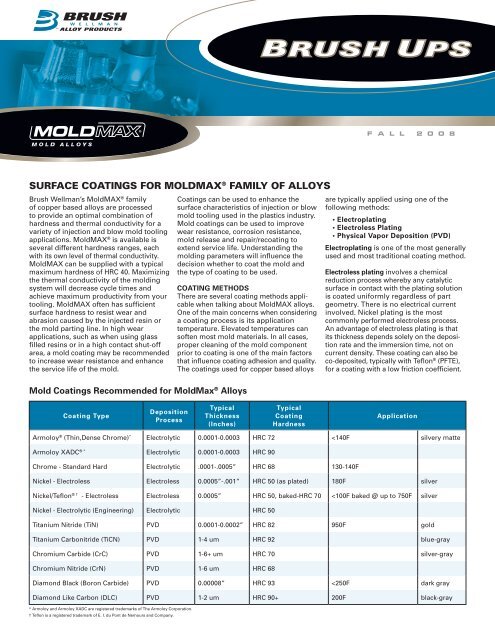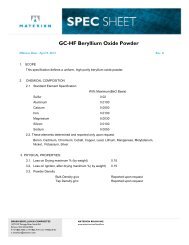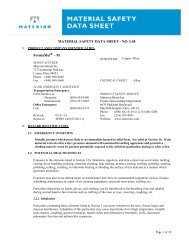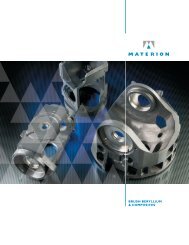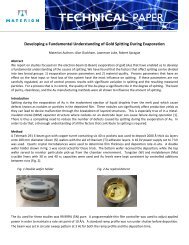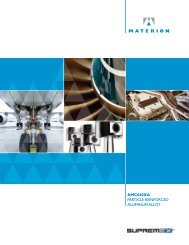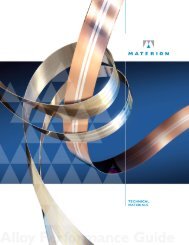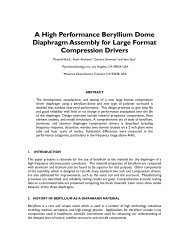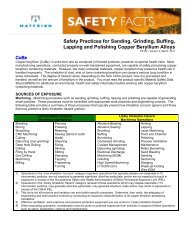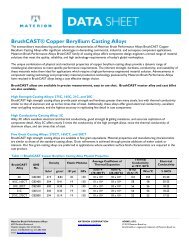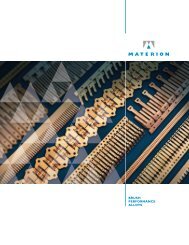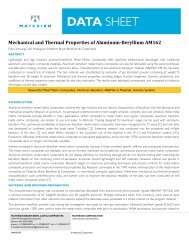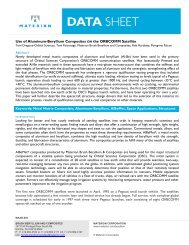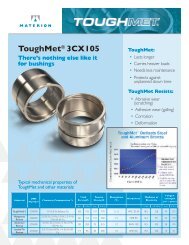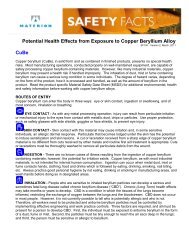surface coatings for moldmax® family of alloys - Materion
surface coatings for moldmax® family of alloys - Materion
surface coatings for moldmax® family of alloys - Materion
You also want an ePaper? Increase the reach of your titles
YUMPU automatically turns print PDFs into web optimized ePapers that Google loves.
F A L L 2 0 0 8<br />
SURFACE COATINGS FOR MOLDMAX ® FAMILY OF ALLOYS<br />
Brush Wellman’s MoldMAX ® <strong>family</strong><br />
<strong>of</strong> copper based <strong>alloys</strong> are processed<br />
to provide an optimal combination <strong>of</strong><br />
hardness and thermal conductivity <strong>for</strong> a<br />
variety <strong>of</strong> injection and blow mold tooling<br />
applications. MoldMAX ® is available is<br />
several different hardness ranges, each<br />
with its own level <strong>of</strong> thermal conductivity.<br />
MoldMAX can be supplied with a typical<br />
maximum hardness <strong>of</strong> HRC 40. Maximizing<br />
the thermal conductivity <strong>of</strong> the molding<br />
system will decrease cycle times and<br />
achieve maximum productivity from your<br />
tooling. MoldMAX <strong>of</strong>ten has sufficient<br />
<strong>surface</strong> hardness to resist wear and<br />
abrasion caused by the injected resin or<br />
the mold parting line. In high wear<br />
applications, such as when using glass<br />
filled resins or in a high contact shut-<strong>of</strong>f<br />
area, a mold coating may be recommended<br />
to increase wear resistance and enhance<br />
the service life <strong>of</strong> the mold.<br />
Coatings can be used to enhance the<br />
<strong>surface</strong> characteristics <strong>of</strong> injection or blow<br />
mold tooling used in the plastics industry.<br />
Mold <strong>coatings</strong> can be used to improve<br />
wear resistance, corrosion resistance,<br />
mold release and repair/recoating to<br />
extend service life. Understanding the<br />
molding parameters will influence the<br />
decision whether to coat the mold and<br />
the type <strong>of</strong> coating to be used.<br />
COATING METHODS<br />
There are several coating methods applicable<br />
when talking about MoldMAX <strong>alloys</strong>.<br />
One <strong>of</strong> the main concerns when considering<br />
a coating process is its application<br />
temperature. Elevated temperatures can<br />
s<strong>of</strong>ten most mold materials. In all cases,<br />
proper cleaning <strong>of</strong> the mold component<br />
prior to coating is one <strong>of</strong> the main factors<br />
that influence coating adhesion and quality.<br />
The <strong>coatings</strong> used <strong>for</strong> copper based <strong>alloys</strong><br />
are typically applied using one <strong>of</strong> the<br />
following methods:<br />
• Electroplating<br />
• Electroless Plating<br />
• Physical Vapor Deposition (PVD)<br />
Electroplating is one <strong>of</strong> the most generally<br />
used and most traditional coating method.<br />
Electroless plating involves a chemical<br />
reduction process whereby any catalytic<br />
<strong>surface</strong> in contact with the plating solution<br />
is coated uni<strong>for</strong>mly regardless <strong>of</strong> part<br />
geometry. There is no electrical current<br />
involved. Nickel plating is the most<br />
commonly per<strong>for</strong>med electroless process.<br />
An advantage <strong>of</strong> electroless plating is that<br />
its thickness depends solely on the deposition<br />
rate and the immersion time, not on<br />
current density. These coating can also be<br />
co-deposited, typically with Teflon ® (PFTE),<br />
<strong>for</strong> a coating with a low friction coefficient.<br />
Mold Coatings Recommended <strong>for</strong> MoldMax ® Alloys<br />
Coating Type<br />
Deposition<br />
Process<br />
Typical<br />
Thickness<br />
(Inches)<br />
Typical<br />
Coating<br />
Hardness<br />
Application<br />
Armoloy ® (Thin,Dense Chrome) * Electrolytic 0.0001-0.0003 HRC 72
Physical Vapor Deposition (PVD)<br />
<strong>coatings</strong> are applied in a vacuum chamber<br />
by vaporizing the coating material and<br />
accelerating it towards the part.<br />
COATING PARAMETERS<br />
FOR MOLDMAX<br />
As mentioned, when preparing a part <strong>for</strong><br />
coating, the <strong>surface</strong> <strong>of</strong> the part must be<br />
clean and free <strong>of</strong> oxidation. This means<br />
the part will typically be degreased and<br />
dipped in an acid solution to remove oxidation.<br />
All copper-based <strong>alloys</strong> will have<br />
a natural copper oxide on their <strong>surface</strong>s<br />
that must be removed <strong>for</strong> good coating<br />
adhesion. Since most metals will s<strong>of</strong>ten<br />
when exposed to elevated temperatures,<br />
it is also important to limit the temperatures<br />
used in the coating process. (Process<br />
temperatures above 550°F <strong>for</strong> MoldMAX<br />
(850°F <strong>for</strong> MoldMAX SC) should be avoided<br />
unless some degree <strong>of</strong> s<strong>of</strong>tening <strong>of</strong> the<br />
base material can be tolerated. Short<br />
time exposures to higher temperatures<br />
may be acceptable depending on the<br />
application. To avoid degradation <strong>of</strong> the<br />
mold material, it is paramount to discuss<br />
these details with your coating supplier.<br />
COATING TYPES<br />
The chart shown on front contains a<br />
description <strong>of</strong> the types <strong>of</strong> coating that<br />
can be used with MoldMAX tooling to<br />
enhance the per<strong>for</strong>mance <strong>of</strong> your mold.<br />
There is normally no one correct coating<br />
to recommend <strong>for</strong> a given application,<br />
as there are per<strong>for</strong>mance trade-<strong>of</strong>fs<br />
with each <strong>of</strong> them.<br />
For an in-depth Tech Brief on<br />
coating MoldMAX, email:<br />
alloypromotions@brushwellman.com<br />
SAFE HANDLING OF COPPER BERYLLIUM<br />
Copper beryllium, like many industrial materials, poses a health risk only if mishandled. In its usual solid <strong>for</strong>m, as well as <strong>for</strong> finished parts, and in most manufacturing operations, it is<br />
completely safe. However, breathing very fine particles, may cause a serious lung condition in a small percentage <strong>of</strong> individuals. Risk can be minimized with simple, proven, and readily<br />
available engineering controls such as ventilation <strong>of</strong> operations producing fine dust. In<strong>for</strong>mation on safe handling procedures is available from Brush Wellman Inc.<br />
FOR ADDITIONAL INFORMATION<br />
For further in<strong>for</strong>mation or technical assistance, contact Brush Wellman’s Customer Technical Service Department in Cleveland, Ohio<br />
at alloy_tech_svc@brushwellman.com or (800) 375-4205. Visit www.MoldMAX.com to learn about our full line <strong>of</strong> MoldMAX mold & tooling <strong>alloys</strong><br />
Brush Wellman’s MoldMAX<br />
<strong>family</strong> <strong>of</strong> mold and tooling<br />
<strong>alloys</strong> now consists <strong>of</strong>:<br />
MoldMAX HH ® Alloy:<br />
Copper Beryllium<br />
Typical Applications: Injection<br />
& blow molds<br />
MoldMAX LH ® Alloy:<br />
Copper Beryllium<br />
Typical Applications: Injection<br />
& blow molds<br />
MoldMAX XL ® Alloy:<br />
Copper Nickel Tin<br />
Typical Applications: Injection molds<br />
MoldMAX SC Alloy:<br />
Copper Beryllium<br />
Typical Applications: Injection<br />
& blow molds, hot runner systems<br />
NEW MoldMAX V ® Alloy:<br />
Copper Nickel Silicon Chrome<br />
Typical Applications: Injection<br />
& blow molds<br />
Visit www.MoldMAX.com to learn about our full<br />
line <strong>of</strong> MoldMAX mold & tooling <strong>alloys</strong>.<br />
Please Note Our Address Change -<br />
beginning Monday, December 8th, 2008<br />
our new address will be:<br />
M o l d M A X P r o d u c t B r o c h u r e<br />
HOT OFF THE PRESSES<br />
Brush has recently published a new MoldMAX<br />
product brochure complete with datasheets<br />
and case histories detailing each <strong>of</strong> the<br />
MoldMAX <strong>alloys</strong> available.<br />
Contact us to request your copy:<br />
alloypromotions@brushwellman.com<br />
Events<br />
February 10-12, 2009:<br />
Plastec West, Anaheim, CA—<br />
Visit Brush Wellman at booth 3811<br />
Visit Brushwellman.com and click on our newsletter<br />
banner to submit your email address and have this<br />
newsletter delivered quarterly to your inbox.<br />
June 22-26, 2009:<br />
NPE, Chicago, IL—<br />
Visit Brush Wellman at booth 130032<br />
Contact us at alloypromotions@brushwellman.com to inquire about complimentary passes<br />
to any <strong>of</strong> our shows.<br />
6070 Parkland Blvd.<br />
Mayfield Hts., Ohio 44124<br />
MoldMAX ® - Mold Alloys<br />
Providing Thermal Management Solutions<br />
BN007<br />
MoldMAX ® , MoldMAX LH ® , MoldMAX HH ® and MoldMAX V ®<br />
are registered trademarks <strong>of</strong> Brush Wellman Inc. © Copyright Brush Wellman Inc. 2008<br />
17876 St. Clair Avenue, Cleveland, Ohio 44110 U.S.A.<br />
www.MoldMAX.com • 888-MoldMAX


